737-215-3211

The Ultimate Guide to Dog Grooming at Home
Whether you're a first-time dog owner or a seasoned pet parent, this guide is tailored to address all your grooming queries and concerns. From basic brushing techniques to more advanced grooming rituals, we cover it all, ensuring your furry friend looks and feels their best.
This guide not only simplifies the grooming process but also deepens the bond between you and your pet, turning grooming sessions into enjoyable, bonding experiences. So, grab your grooming tools, and let's embark on this journey to achieve a happier, healthier, and well-groomed pup!
Why Grooming Your Dog is Important
Grooming your dog regularly is vital for various reasons, both for their physical health and overall well-being. Here are six key reasons why dog grooming is important:
Skin and Coat Health
Regular grooming, including brushing and bathing, helps remove dead hair, dirt, and dander from your dog's coat. It also helps to distribute natural oils in their skin, keeping their coat shiny and healthy. For dogs with longer hair, regular grooming prevents painful matting and tangling.
Early Detection of Health Issues
Grooming sessions allow you to closely examine your dog's body for any abnormalities like lumps, bumps, skin lesions, or signs of infections. Early detection of these issues can lead to quicker treatment and resolution.
Parasite Detection and Control
While grooming, you can spot and address external parasites like fleas and ticks, which are not only uncomfortable for your dog but can also lead to health issues like allergies, infections, or transmission of diseases.
Nail Trimming
Overgrown nails can cause discomfort and, in severe cases, lead to structural problems or pain in your dog's feet and legs. Regular nail trimming is essential for maintaining good posture and mobility.
Ear Cleaning
Regular cleaning of your dog's ears is crucial, especially for breeds prone to ear infections. It helps prevent the buildup of wax and debris, reducing the risk of infections and irritation.
Eye Care
Grooming around the dog's eyes is important, especially for breeds prone to tear staining or eye discharge. Keeping this area clean can prevent infections and discomfort.
Improved Hygiene and Comfort
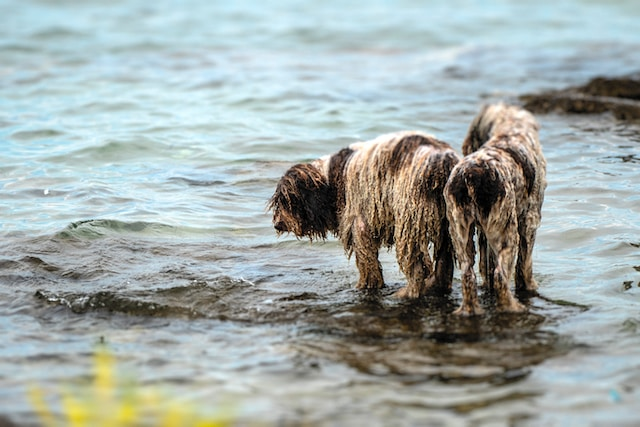
Regular grooming keeps your dog clean, reducing the chance of bad odors and making them more pleasant to be around. It also ensures that your dog is comfortable, as matting, knots, and parasites can cause significant discomfort.
Bonding Experience
Grooming sessions can be a wonderful bonding experience for you and your dog. It's a time of close contact and gentle handling, which can strengthen your relationship and build trust.
Essential At Home Grooming Tools And Supplies
For effective at-home grooming of your dog, it's essential to have the right tools and supplies. Each tool plays a specific role in maintaining your dog's coat, nails, and overall hygiene. Here's a list of essential grooming tools and supplies for at-home use:
Brushes and Combs
-
Slicker Brush: Ideal for removing mats and tangles, especially in long-haired dogs.
-
Bristle Brush: Suitable for short-haired dogs to remove loose hair and stimulate the skin.
-
Pin Brush: Good for dogs with medium to long hair.
-
De-shedding Tool: Helps to reduce shedding in dogs with undercoats.
-
Flea Comb: Used to detect and remove fleas and their eggs.
Clippers and Scissors
-
Electric Clippers: Necessary for trimming the hair of dogs with thick or long coats.
-
Scissors: Useful for precision trimming around the face, ears, and paws.
-
Thinning Shears: Helpful for thinning out thick hair without changing the overall length.
Nail Clippers or Grinder
-
Clippers: Used to trim nails to a comfortable length.
-
Nail Grinder: A more gradual, less stressful way of trimming nails, especially for dogs scared of clippers.
Shampoo and Conditioner
-
Dog-specific Shampoo: Choose a formula suitable for your dog’s skin type (e.g., sensitive, dry, itchy). Don't use human shampoos because they might contain ingredients harmful to young puppy skin and coat.
-
Dog Conditioner: Helps to detangle and soften the coat, especially for long-haired breeds.
Ear Cleaning Supplies
-
Ear Cleaner: A veterinarian-approved ear cleaning solution.
-
Cotton Balls or Pads: Used for gently cleaning inside the ears.
Dental Care Supplies
-
Dog Toothpaste: Never use human toothpaste as it can be toxic to dogs.
-
Toothbrush: Designed specifically for dogs.
Grooming Wipes or Spray
-
For quick clean-ups and to keep your dog smelling fresh between baths.
Towels and Hair Dryer
-
Absorbent Towels: For drying your dog after a bath.
-
Hair Dryer: Use on a low heat setting for dogs who tolerate it, to speed up the drying process.
Dog Grooming Process: Step-By-Step Guide
The grooming process can be an enjoyable experience for both you and your dog when done correctly. Here's a detailed step-by-step guide covering the main aspects of grooming:
Brushing Your Dog
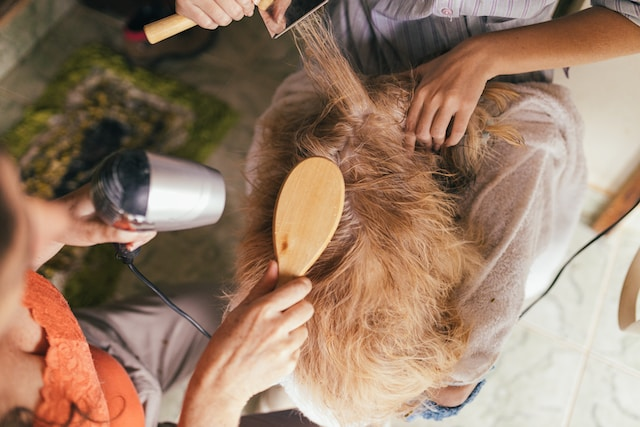
Brushing your dog's fur regularly is an essential part of grooming. It removes dirt, dander, and loose hair, and prevents matting. Brushing your dog's hair distributes natural oils throughout your dog's coat, helping to keep their coat shiny and healthy.
The first step is to choose the right brush for your dog's fur type.
-
Short Coats: Use a bristle brush to gently remove loose fur and stimulate the skin. Regular brushing once a week suffices.
-
Medium and Long Coats: Start with a detangling tool or slicker brush to address mats, followed by a bristle or pin brush for thorough grooming. This should be done several times a week to remove dead hair and avoid matting.
-
Curly or Wooly Coats: These require daily brushing with a slicker brush to prevent severe matting and tangling.
-
Double Coats: Utilize an undercoat rake for the dense underlayer, especially during shedding seasons, followed by a regular brush for the top coat.
When brushing your dog at home, start at the head and work your way down to the tail. Always brush in the direction of hair growth. Use short, gentle strokes, focusing on one section of your dog's coat at a time. Pay special attention to your dog's underbelly, legs, and tail, as these areas are prone to tangles and mats.
Use a dog brush or comb to detangle any small knots or tangles, being careful not to pull or tug on your dog's hair.
Bathing Your Dog
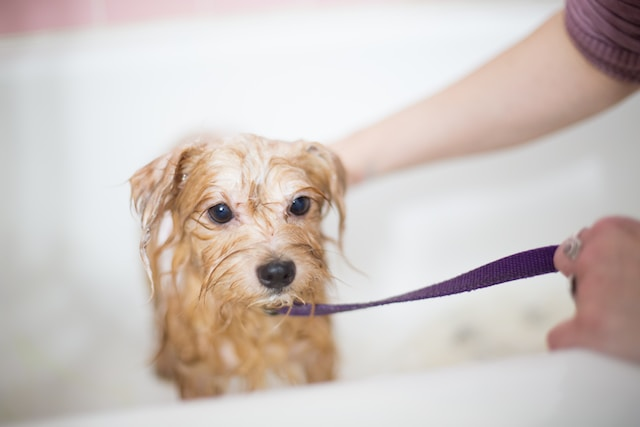
The grooming session is not complete without bathing. Bathing removes excess oil, dirt, and odors from your dog's skin and coat. It's also an opportunity to check for skin issues. That's why when you groom your dog, you must always bathe them. Here's how:
-
Preparation: Gather all supplies and use a non-slip mat in the bathtub. If you don't have a bathtub, you can use Shelandy Heavy Duty Dog Grooming Tub.
-
Water Temperature: Lukewarm or warm water is ideal.
-
Washing: Wet your dog thoroughly. Use a dog-specific shampoo like Lakeside The BatherBox Oatmeal Shampoo. Lather and massage gently. Avoid your dog's eyes, mouth, and ears. You can use bath time gloves.
-
Rinsing: Thoroughly rinse to avoid residue, which can cause skin irritation.
-
Apply Dog Conditioner (if desired): Massage your Lakeside The BatherBox Go To Conditioner on your dog's coat.
-
Rinsing: Rinse off all the conditioner to avoid irritation.
-
Drying: Towel dry gently, and if your dog is comfortable, use a blow dryer like K-9 Dryers Fluffer Dryer™ in a cool setting. Most dogs are not comfortable with dog grooming dryers. As dog owners, you must know if your pup is one of them.
Nail Care
Keeping your dog's nails trimmed is essential to prevent discomfort and injury. It also prevents discomfort in walking, joint pain, and other nail-related injuries. Here's how to trim your dog's nails:
-
Use sharp, high-quality dog clippers designed for dogs. Don't use normal human nail trimmers.
-
Hold your dog's paw firmly but gently.
-
Clip the tip of the dark nails, being careful not to cut the quick (the pink area that contains blood vessels).
-
Trim small sections at a time to avoid bleeding and pain.
-
If you accidentally cut the quick, apply styptic powder to stop the bleeding.
-
Use a nail file to smooth any rough edges.
Alternatively, you can use a nail grinder to file your dog's nails instead of clipping them. Trim as often as needed to keep the nails at a comfortable length, typically every 3-4 weeks.
Ear Cleaning
Regular ear cleaning prevents wax build-up and infections and can help identify any ear-related issues early. Here's how to clean your dog's ears:
-
Choose a gentle ear cleaner, like Petique Odor Eliminating Ear Cleaner, specifically designed for dogs. You can ask your veterinarian for recommendations.
-
Apply a few drops of the ear cleaner to your dog's ear canal.
-
Massage the base of your dog's ear to help distribute the cleaner.
-
Use cotton balls to wipe away dirt and debris from your dog's ears.
-
Repeat the process on the other ear.
You can also use a cotton ball soaked in ear cleaner. Then, gently clean the outer ear and the entrance of the ear canal. Clean your dog's ears every few weeks or as recommended by your vet, especially in breeds prone to ear problems.
Hair Trimming

Trimming your dog at home keeps your dog's coat neat, reduces matting, and is essential for breeds with fast-growing hair.
-
Use sharp, dog-specific scissors or clippers.
-
Begin trimming in the direction of hair growth. For scissors, use small snips to avoid uneven cuts. For clippers, move them slowly and steadily. Pay special attention to sensitive areas like the dog's paw pads, face, and ears.
-
Give your dog breaks to prevent anxiety or restlessness. This also gives you a chance to step back and check your work.
-
Keep the skin taut to avoid nicks, especially in areas where the skin folds. Never rush the process, as quick movements can startle your dog.
-
Use scissors for finishing touches around the ears, paws, and tail. These areas require precision, so take your time.
-
Once finished, brush your dog's coat again to remove any cut hairs. Reward your puppies with dog treats, like Omega Fields Smart Hearts Dog Treats, and affection for their cooperation.
Remember, patience is key. It's okay if the first few attempts aren't perfect, especially for first-time pet owners. With practice, you'll learn what works best for your dog's coat type and your personal comfort level. If you're ever in doubt, consult a professional groomer for tips specific to your dog's breed.
How To Handle Common Dog Grooming Challenges
Handling common dog grooming challenges requires patience, understanding, and sometimes a bit of creativity. Here are strategies for dealing with some of the more frequent issues encountered during at-home dog grooming:
-
Fear of Water or Bathing
-
Gradual Introduction: Slowly acclimate your dog to the bath. Start by placing them in an empty tub, then gradually introduce water.
-
Comfort Measures: Use a non-slip mat in the tub, and ensure the water is comfortably warm, not hot.
-
Distraction and Rewards: Offer treats and toys to create a positive association with bath time.
-
-
Matted Fur
-
Preventative Brushing: Regular brushing can prevent mats from forming, especially in long-haired breeds.
-
Detangling Sprays: Use a detangling spray or conditioner to help loosen mats.
-
Gentle Approach: Carefully tease out mats with a comb, working from the ends upwards. Avoid pulling hard, which can cause pain.
-
-
Handling Squirmy or Restless Dogs
-
Exercise First: A good play session before grooming can help expend excess energy.
-
Short Sessions: Keep grooming sessions brief and positive, gradually increasing duration over time.
-
Assistance: Having a family member or friend gently hold and soothe the dog can help.
-
-
Post-Grooming Zoomies
-
Calm Environment: Keep the grooming environment calm and stress-free.
-
Post-Grooming Play: Allow some time for play or a walk after grooming to help your dog expend pent-up energy.
-
Dog Grooming At Home: Tips & Tricks
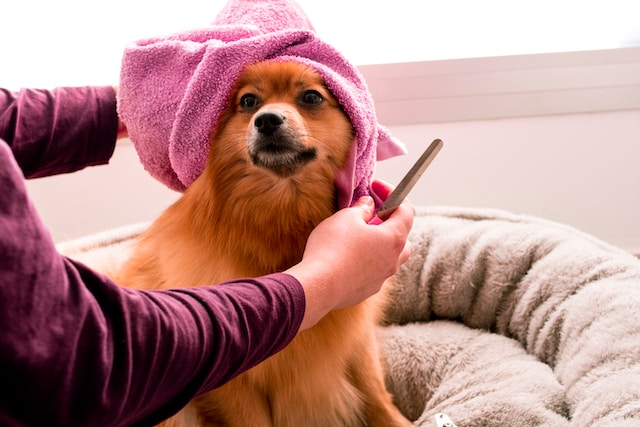
Grooming your dog at home can be a fulfilling experience, enhancing your bond while keeping them clean and healthy. Here are some important grooming tips and tricks to make the process more efficient and enjoyable for both you and your furry friend:
-
Start Young: If possible, introduce grooming to your dog when they're a puppy. This helps them get used to the process and become more cooperative as they grow older.
-
Regular Brushing: Regular brushing is key to preventing mats and tangles, especially in long-haired breeds. It also helps distribute natural oils throughout the coat, promoting healthier skin and fur.
-
Right Tools for the Coat Type: Use grooming tools appropriate for your dog’s coat type. For example, bristle brushes work well for short-haired breeds, while slicker brushes are better for dogs with thicker, longer fur.
-
Ear Care: Clean your dog's ears regularly, but gently. Use a vet-approved ear cleaner and avoid inserting anything deep into the ear canal.
-
Eye Maintenance: For breeds with long hair around the eyes, keep this area trimmed to prevent irritation. Always be extra careful when trimming near the eyes. If you're scared to trim the fur around or close to the eyes, don't hesitate to contact professional groomers.
-
Positive Reinforcement: Always associate grooming with a positive experience. Use dog treats and praise to reward your dog for good behavior during grooming sessions.
-
Be Patient and Observant: Many dogs are comfortable with grooming initially. Be patient and observe their reactions to different aspects of grooming to understand their comfort levels.
Grooming Special Needs Dogs
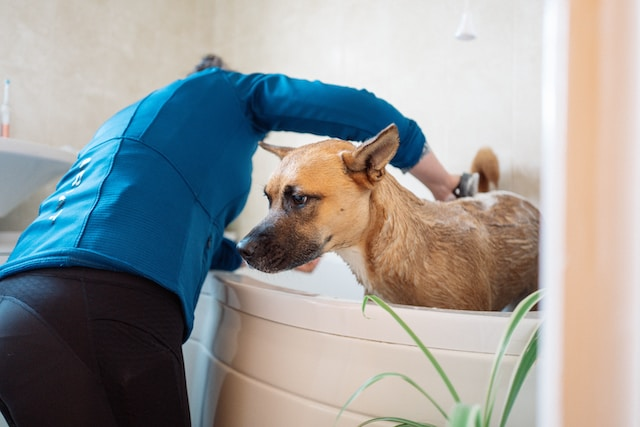
Grooming your dog at home with special needs, whether due to age, health issues, or temperament, requires extra care and attention. Here are some simple tips to make the grooming process comfortable and safe for these special companions:
-
Be patient and gentle. Dogs with special needs may require more time to adjust to grooming. Be patient and gentle, offering reassurance and breaks as needed.
-
Adapt to your dog's comfort level. Pay attention to your dog's reactions and adapt your grooming techniques accordingly. If certain positions or movements seem to cause discomfort, adjust your approach.
-
Create a calm environment where your dog is comfortable. Choose a quiet, well-lit space for grooming. Minimize noise and distractions to keep your dog calm. Using a familiar and comfortable spot can help reduce anxiety.
-
Use the right tools. Choose tools that are comfortable for both you and your dog. For example, a soft-bristled brush for sensitive skin or a quiet hair dryer for dogs startled by noise.
-
Be very careful when trimming your dog's nails. Keep your dog's nails trimmed to prevent discomfort when walking. If your dog is anxious about nail trimming, consider using a nail grinder for a more gradual approach.
-
Consult with your veterinarian. Before starting a grooming routine, consult your vet, especially if your dog has health issues. They can offer advice tailored to your dog's specific needs and conditions.
FAQs
How often should I groom and bathe my dog at home?
The frequency of grooming will depend on your dog's breed, coat type, and lifestyle. Dogs that spend more time outdoors or have long hair require more frequent grooming than those with short hair. As a general rule, dogs should be groomed at least once a month.
What's the best way to brush my dog's teeth?
Use a soft-bristled toothbrush and a toothpaste specifically designed for dogs. Start slowly and reward your dog with treats and praise. Never use your toothpaste and toothbrush. Human toothpaste includes various ingredients that are harmful to dogs. Ordinary human toothbrush is also harder than dog toothbrush.
Can I use human shampoo on my dog?
No, it's not recommended to use human shampoo on your dog. Human shampoo is formulated for the pH level of human skin, which is different from that of dogs. Using human shampoo can disrupt the natural pH balance of your dog's skin, leading to irritation, dryness, or skin disorders. It's best to use a shampoo specifically designed for dogs, as it's formulated to suit their skin's pH and needs.
How can I prevent my dog from shedding?
To minimize shedding in your dog, regularly brush their coat, provide a balanced diet rich in essential fatty acids, ensure they are properly hydrated, and keep up with regular vet check-ups for overall health. While shedding is a natural process for most dogs, these steps can help manage and reduce the amount of loose hair.
Should I groom my dog myself or take them to a professional groomer?
It depends on your comfort level and your dog's grooming needs. If you have a short-haired breed that requires minimal grooming, you may be able to handle it at home. However, if you have a long-haired breed that requires extensive grooming or if your dog has special needs, it may be best to seek professional help.
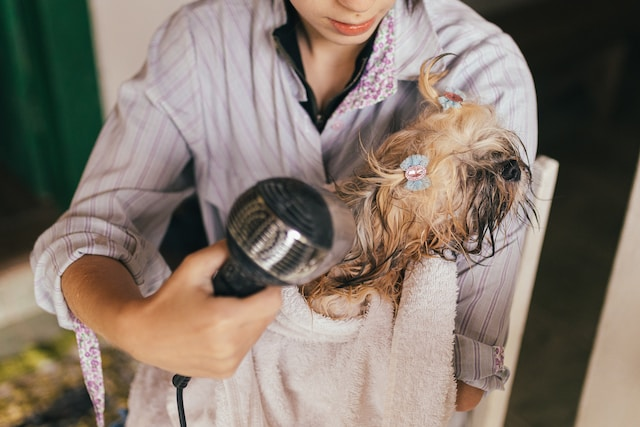
Groom Your Dog At Home Using Puppy Fever Pro's Grooming Products!
Remember, grooming your dog is an important part of responsible pet ownership. With the right tools from Puppy Fever Pro and grooming techniques, you can keep your furry best friend looking and feeling their best.
Combine these tips with our dog grooming tools and supplies and grooming at home will become easier and more comfortable for you and your pet. Browse through all our products today!
For more tips and tricks for dog owners, visit our blogs.


Leave a comment